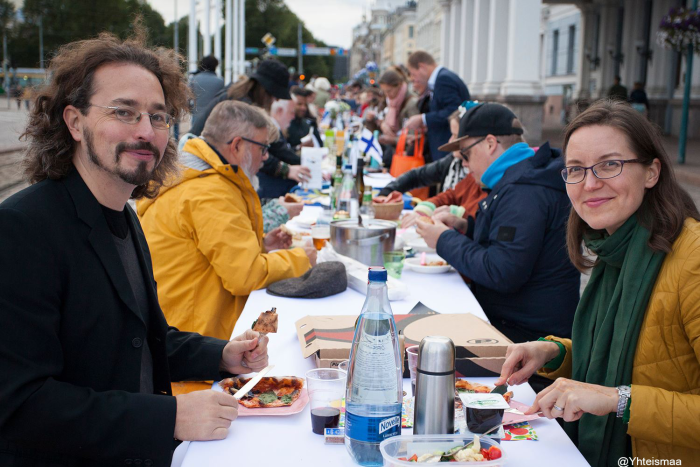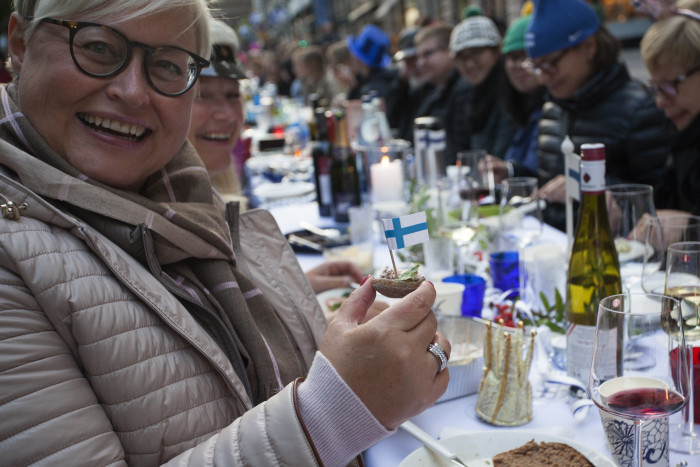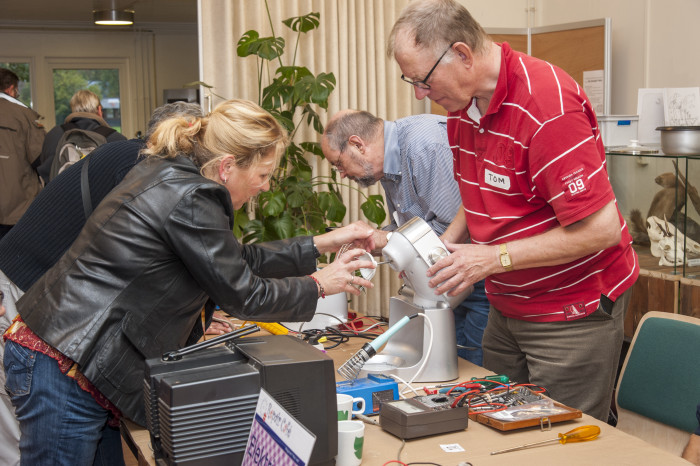GyeongGi Cultural Foundation
Common Urban Culture
Cultural Policy is a quarterly magazine published by the Gyeonggi Cultural Foundation since the summer of 2017 with the purposes of identifying new trends in cultural policies at home and abroad, gathering the opinions of experts in relevant areas, and introducing the directions and contents of diverse cultural policies promoted by Gyeonggi Provincial Government and Gyeonggi Cultural Foundation. |
Writer | Jiyeon Cho
Recent trends and issues are often focused on transforming the existing cities into ‘Smart cities’ by forming a network of the cities’ public functions. Meanwhile, the issue of ‘Regeneration,’ which is a cultural process of involving citizens, would be local culture or the city itself that is enabled by residents’ interest in society and their increased participation. This leads to expectations for how to publicly connect a city’s open space and activities and how to make them accessible. In an attempt to study relevant cases abroad, a delegation of GyeongGi Cultural Foundation’s Culture and Arts Headquarters (Six persons from the Culture and Arts Promotion Team, Local Intermedia Team (Sangsang Campus), GyeongGi Northern Culture Initiatives and Management Support Team) visited Amsterdam and Helsinki for ten days from August 28 to September 6, 2017.
Rather than emphasizing technical aspects, this visit was focused on finding planners who create
community culture and small differences and factors that led to spreading their networks
and movements. We conducted preliminary research to study local projects with the following
keywords: city, technology, citizens, space, design and publicness. We then met with local planners
to have interview with them.
We interviewed organizations that are motivated by social issues to involve people: Repair Cafe, Yhteismaa, Free house and Cascoland. This paper elaborates on their activities. We also interviewed spaces where artists, innovators and technology developers stay to prepare for the future: Kappeli. Fiskars Village and Design Factory. In addition, we visited museums, art centers and cultural complexes: Korjaamo Culture Factory, Annatalo Arts Center, Helsinki Design Museum and Westergasfabriek. Above all, we tried to understand how the organizations came to lead cultural activities that have great value and special issues and how they are run. This visit served as an occasion to reflect on planners’ role once again and to reaffirm Gyeong- Gi Cultural Foundation’s vision supporting the social changes and movements they have led.
Yhteismaa
Yhteismaa is a nonprofit organization that was founded in 2012 to pursue new participatory urban culture, co-production and social changes. The organization is better known as ‘Restaurant Day’ and ‘Dinner under the Sky.’ At ‘Dinner under the Sky,’ vehicles are controlled in Esplanadi, Helsinki and a 500-meter table is ready for 1,000 people who bring and share food for dinner. This event started by celebrating Helsinki’s birthday on June 12, 2013. On this occasion anyone can put smaller tables everywhere in Helsinki including parks to participate in this event. The activity of sharing food in public space began in May 2011 with Restaurant Day. Designed to help people share their food and daily life during a day on the street, this food festival’s small movement is now going beyond the Scandinavian Peninsula to reach the world.
However, if this occasion is seen as a festival or event, it would not seem to be very special to Korea, which organizes a great number of big festivals. Public space can be planned and controlled in order to enrich leisure activities and to improve a local community’s quality of life. In this context, Yhteismaa’s events are interesting in that they help people understand that they are leaders of public space. They actually occupy the space temporarily and all of them participate in the same daily activities.



@Yhteismaa
To find out the organization’s goal, meaning and secrets behind its expansion, we had conversation with Pauliina Seppala, founder of Yhteismaa. The name of the organization ‘Yhteismaa’ means ‘common’ in Finnish. As the name implies, the organization pursues a sense of responsibility to lead one’s own city, community life shared with everyone and environmental value. Its projects share the purpose of social and urban life which is about having more fun, being free, being sustainable and taking responsibility. ‘Clean Day’ (Siivous Paiva in Finnish) also transforms the entire city into a huge marketplace crowded with thousands of people. On this occasion, people can sell anything including clothes, books and even their special techniques anywhere including streets, parks, vacant lots and their houses. Sellers register the products they will sell and selling venues on the event’s website. Buyers then find the venues where they can buy what they want, thanks to a map provided by the event’s smartphone application or website. What is notable is the fact of the activeness of participants connecting every corner of Helsinki. ‘Restaurant Day’, ‘Clean Day’ and ‘Dinner under the Sky’ are neither events nor projects run by experts for the public. Instead, participants’ active role contributes to creating urban culture. Just as in the recent case of “living labs” that enable users to participate in the innovative activities of their local community and society, users are required to play more active roles.
Then, what is the source of the solidarity and sense of belonging of unspecified individuals who participate in the events run by Yhteismaa? The interview let us understand that such solidarity is based on social media in which people participate voluntarily. Pauliina ran an online platform from 2010. This was a crowdfunding platform in the field of arts and culture and it enabled many people to network through social media called mahdollista. Such networking through the online platform continued afterward. That may because Seppala has actively used an online platform for each project. For example, participants indicate spots on the map themselves. What is meaningful is to communicate and share interests through a mobile system. After Dinner under the Sky, Seppala began to plan and run another platform called “nappi naapuri” (meaning “neighbor”). This website, which gathers together neighbors influencing the city of Helsinki, has attracted 10,000 visitors who registered. They can know their neighbors and they have meetings around their neighborhood. Such small meetings in Helsinki will also become special when people are connected through social media to occupy public space and to share personal, daily experience with everyone.
Repair Cafe
A Repair Café is a local community space to which people bring anything broken, serving as a technological model for community cooperation. The space is forming a culture of voluntary repair. It started in Amsterdam, the Netherlands and spread throughout the world. Their number now reaches about 1,371. Before visiting the Repair Café Foundation, we visited one of the Repair Cafés.
When we went into a Repair Café located at Huis van de Wijk, people were having a meeting for the repair of electronic products (11 a.m. to 1 p.m. on Mondays). Some of them were repairing a radio that wasn’t working and others were repairing cloth with a sewing machine. Those who weren’t working were just talking to each other over a cup of coffee. They seem to have nothing special. Most of the volunteers are the elderly. Five among them are voluntarily serving their community with different repair techniques. This café, where they repair clothes, furniture, electronic products, bicycles, toys and so on, needs only a million won to run the space. A Repair Café’s table has different kinds of equipment and its cabinets also have tools and equipment. They either bring their own tools or they share them.
The cafe’s founder Martine Postma was once shocked when she saw usable objects thrown away on the street. She then started thinking, “Is it helpful or wasteful for economy to boost consumption?” It was the beginning of the Repair Café. Transforming herself from an environmental journalist to a social innovator, she noted the fact that local communities have many retirees engaging in voluntary activities. She then started gathering together those who joined her to found the Repair Café with three purposes: easy, fun and cheap. Martine says that the café has been a success because people can not only have fun but also they find the café useful. Consequently, the café connects people and helps them solve problems together. Those who don’t want to throw out things constitute a driving force behind the successful management of the café. Martine emphasizes that their voluntary participation is important.

@Martin WaalboerRepair Cafe International Foundation
With a goal of making itself accessible in local communities, a Repair Café can be opened by anyone and run independently and autonomously. Its management is easy because café members are just required to have monthly meetings and submit simple reports. To run a Repair Café, you need to buy a manual kit for the Repair Café which is 49 euros. No interview or paper work is needed to become a member of the Repair Café and run the space. What is notable is the kit’s manual which is translated into eleven languages. This manual provides a detailed explanation on how to run the café so even beginners find it easy to follow it. The kit’s information is as follows: purpose of the café, locational conditions, management principles including publicness, different categories of tools needed for the space, method of recruiting volunteers with repair techniques, guide to serving visitors, making posters and where to put them and media promotion process. However, if it is easy for anyone to open a café, it would also be easy to close it. We thus asked Martine if there have been cases of closing or dissolution. She said that there were some cases. For example, when a member of the café cannot find volunteers with repair techniques or if he or she faces locational problems or internal disputes, the member needs to decide if he or she will continue to run the café. In such cases, the Repair Café Foundation serves as a mediator. No monitoring or control exists between the Repair Café Foundation individual cafés. Consulting on the café’s manual and exchange of ideas take place on Facebook and the Repair Café’s website. The Repair Café’s future vision is to add more cafés (1,371 cafés currently), repairable items (coffee machine, bicycle, radio, etc.) and technicians. Its long-term plan is to join elementary education and its ultimate goal, to make a sustainable society.
Just like Yhteismaa, a planner’s role at the Repair Café is to create concepts and values needed by society and spread them. Yhteismaa’s direct point is to take responsibility in leading one’s city. In the same vein, the Repair Café, which pursues ease and fun, also seems to have found a good connecting point where people are linked to each other to solve problems together. Although the two organizations may differ in terms of how to implement their projects, what they have in common is the fact that there isn’t any artificial planning or selection process. It is up to participants to build on a process to make a project concrete. What we observed in the two cases is the connecting point where they involve voluntary participants. The relationship between the planner and participants is horizontal and interactive. Such a relationship is also found in intermedia’s attitude of communicating with a local community illustrated by the following two cases.
Freehouse and Cascoland
Starting with projects led by groups of artists, Freehouse and Cascoland have served as spaces for local residents’ activities for ten and eight years respectively. They are located in an multinational area of Rotterdam and immigrants’ zone in northwestern Amsterdam respectively. Freehouse was launched in 2008 with a project led by the artist Jeanne van Heeswijk. In 2012, it began to be connected to the local community and to collaborate with local residents in earnest in 2012 with a project called the Market of Tomorrow, thus becoming Rotterdam’s first cooperative. It doesn’t mean that Freehouse changed its structure to that of a cooperative but that it took the lead in growing into a cooperative called AFRI KAANDER which encompasses the entire local community. It was funded for several years but since 2014, it has been run with its own revenue. Local women led the management of their neighborhood kitchen, thus contributing to the organization’s expansion to community business with their catering service. Meanwhile, men participated in collecting recyclable waste and consequently, 57 men came to find new jobs.
The artist figured out the problem was that the local market didn’t have a variety of items to buy, leading to its deterioration. It was thus urgent to make strategic points out of agoratype and multiethnic marketplaces in order to strengthen diversity and invigorate them. The artist then collaborated with another artist to change the local market’s kiosks and to have a fashion show beside a clothes store, thus attempting to transform the market into a place with something to see. The artist also ran a neighborhood handicraft workshop using sewing machines and cloth. As she came to attract participants of the workshop, she collaborated with a professional designer to display products made in collaboration with local residents. A uniform was also made for the workshop.
"Just like Yhteismaa, a planner’s role at the Repair Café is to create
concepts and values needed by society and spread them.
Yhteismaa’s direct point is to take responsibility in leading one’s city.
In the same vein, the Repair Café, which pursues ease and fun,
also seems to have found a good connecting point where people are linked
to each other to solve problems together. Although the two
organizations may differ in terms of how to implement their projects,
what they have in common is the fact that there isn’t
any artificial planning or selection process.
It is up to participants to build on a process to make a project concrete."
After launching an intervention project regarding artistic involvement as cultural development, the artist expanded it to different stores worth collaborating with such as the handicraft workshop and kitchen, generating socioeconomic effects. The artist took the lead in transforming personal spaces into public ones to make them visible.
Another example is Cascoland. It was launched in 2010, when the Netherlands faced a financial crisis and stopped growing. Under these circumstances, the country had to deal with a stagnant real estate market in northwestern Amsterdam. The city then requested this project in order to revitalize this area. The space was rented from a construction company for free to communicate with the local community. Architects, artists and designers came together and presented flash mobs and performances in an attempt to raise public awareness. In this research process, they had to understand how people were living and what the area’s characteristics were. Afterward, they decided to ‘redesign’ the area to encourage people to use it. For example, they showed a performance where they put a bed on an unsafe street and slept on it comfortably. They also installed a teahouse structure on the street in order to create a new venue of negotiations. They also made a movable garden and kitchen to communicate with people in public space. Such performances lead to changing residents’ perspective. They made use of sites that had been abandoned in immigrants’ residential area in order to transform them into public ones. Listening to residents’ opinions, they used the space to grow vegetables and chickens and to make it part of their common assets. The artist, who felt the limits of communicating through workshops earlier, decided to go out on the street holding signs and to share ideas with local residents in person. Asked about the secret behind such trust from the city, the artist answered, “Enthusiastic support from citizens.” The artist is making constant efforts to motivate and coordinate local residents because the project may be stopped sometime in the future. The artist said that mothers and women serve as local mediators and constitute a global hub. Sometimes, intervention in the local community can be seen as expanding into the social and local economic area by linking people to people and creating another communication with the region.
The projects mentioned above are sponsored by an institution called DONE Foundation. Established in 1991, this foundation is a sponsoring institution located in Amsterdam. It is run with three lottery funds (Nationale Postcode Loterij, Bank Giro Loterij and Vrienden Loterij). The foundation divides the teams it supports into three categories: green, social and creative teams. As of 2015, the foundation supports about 273 teams with about 32,389,587 euros. The ‘creative’ category is divided again into detailed programs: global culture and media, culture’s social role and social design. There is no artistic field focused on genres and most of the foundation’s support is focused on social activities. In other words, the foundation regards ‘social activities’ as society’s ‘culture.’ Thus, what matters is the artistic method with which an already existing local community functions, communicates or expresses itself. It was impressive to view all social activities, which include creation, economy, innovation and experiment, as something to foster. The vision of the foundation, which supports all of this, showed the confidence of using public space. Social activities that are activated under these circumstances seem to create a ‘shared urban culture.’
Cultural Policy Bulletin Vol.2 E-book
<Copyright(c)2002 GGC All rights reserved.>
information
Writer/ Jiyeon Cho, Manager of Local Intermedia Team at GyeongGi Cultural Foundation
keywords
- Writer
- GyeongGi Cultural Foundation
- About
- Everything about the GyeongGi arts and culture, GGCF
- homepage
- https://www.ggcf.kr/